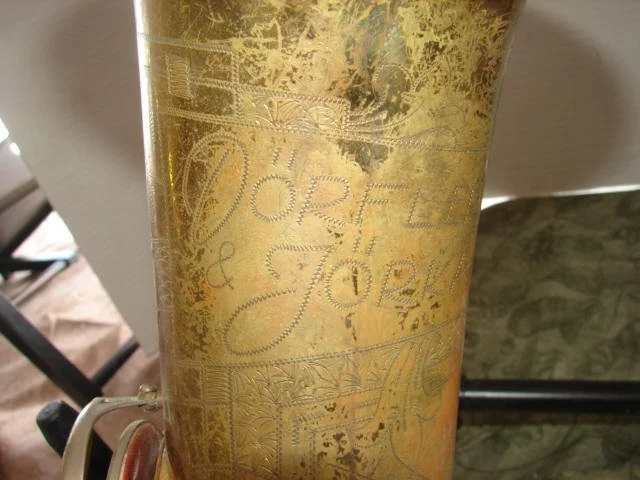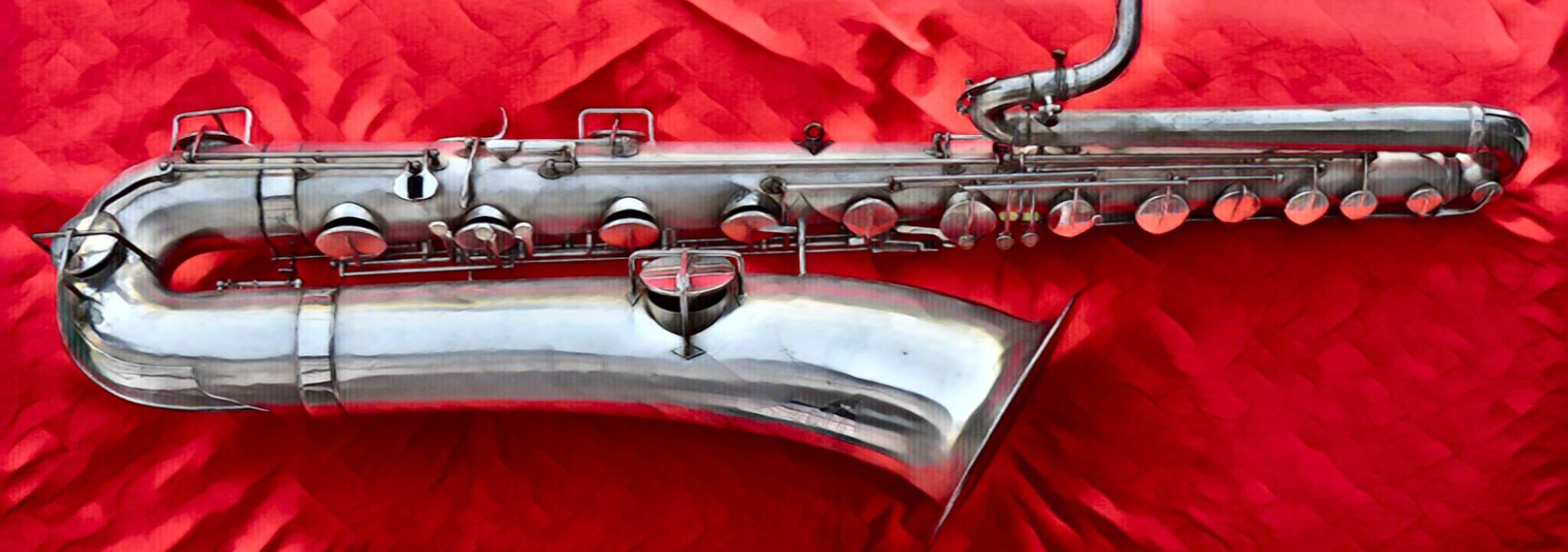 It has been quite some time since I wrote anything about Dörfler & Jörka (D&J) saxophones. Bassic Sax has what is pretty much the definitive D&J page on the Net, and this article is now part of the series of articles dedicated to this mid-century German manufacturer of Keilwerth clone horns. (See list on right.)
It has been quite some time since I wrote anything about Dörfler & Jörka (D&J) saxophones. Bassic Sax has what is pretty much the definitive D&J page on the Net, and this article is now part of the series of articles dedicated to this mid-century German manufacturer of Keilwerth clone horns. (See list on right.)
A couple of weeks ago I received an email from someone informing me of a D&J stencil by the name De Villier up for sale on eBay. This peaked my curiosity, since De Villiers was the stencil name that sent me down the rabbit hole of D&J research to begin with. Now the name has appeared again, but sans the letter “s” to end the name.

This alto sax has the typical D&J engraving, as well as the rolled tone holes. It was no doubt made by Dörfler & Jörka.
For comparison, the following is what the engraving on my D&J tenor looked like. (Past tense, since I sold it last year.)

Note the slightly different engraving on my tenor. D&J did have a variety of engraving styles on their horns. The multiple peaks on the alto currently for sale on eBay, and shown above, is by far and away though the most common.
What the current owner of the De Villier alto by Dörfler & Jörka says about their instrument
Like pretty much every D&J owner, this seller manages to conflate the D&J/JK connection and states this is a Keilwerth stencil, which it is NOT. It is describes as follows in the eBay ad:
Keilwerth stencil Alto Saxophone with De-Villier name on bell. Has rolled tone holes. Needs Overhaul. This is a vintage Keilwerth stencil saxophone made in Germany with the De-Villier name on the bell. These Dorfler & Jorka horns are renowned for their huge sound. They have a big fat tone especially on the altos and they are quite easy to play. Serial # 9039. These older horns have been tried and true, they hold their own very well. Solid well built horn with rolled tone holes. No dents just about 2 or 3 pinhead size dings. Horn needs overhaul.
What are the differences between this De Villier alto and the De Villiers tenor vis-à-vis Keilwerth?
- Both were made by D&J
- Both check all the boxes from the D&J page on Bassic Sax that indicate they are D&J and not Keilwerth horns:
| Neck fastening screw | Key Guards | Post Shapes | Clothes Guard | |
|---|---|---|---|---|
| Dörfler & Jörka | A round thumb screw attached to the socket | MOP buttons on guards made it impossible to adjust the underlying felts for precise key height adjustments | Cone-shaped | Metal (missing on the alto) |
| Julius Keilwerth | Conventional neck fastening screw | Felt on the guards that allow for precise key height adjustment | Two trapezoids stacked on top of each other | Lucite or metal (depending on year and/or replacement) |
Compare / Contrast the De Viller alto and De Villiers tenor
Quite frankly, there are really not many differences between these 2 horns besides the obvious alto/tenor one.
What are the origins of De Villier/s saxophones?
Ever since I first got my De Villiers tenor back in 2009, I have been trying to piece together the history of this stencil brand. D&J made saxophones for/under so many different names that it is simply impossible to try and track down the majority of the ordering companies.
Music stores and ordering companies have long been shuttered, and most long forgotten. And with Keilwerth not having any records pertaining to the company (D&J) they took over, we are left to Google in the vain hope of stumbling upon a shred of info about brand X or Y that might pertain to what we’re looking for.
Until this De Villier alto from D&J came up for sale, I had not seen another D&J-made De Villier(s) anything. I had however, come across a number of cheap, Asian-made De Villier-branded saxes on eBay over the years. They look like utter crap. (I believe I might have more in my files that I haven’t uploaded to the Bassic Sax Pix galleries yet.)
The one possible link to the De Villiers name that I did find, is the French musician and educator named, Michael De Villiers. He played saxophone and clarinet, and was also a band leader, as well as a jazz, radio, and screen writer. As a performer, his music is widely available digitally these days through many download and streaming services.
De Villiers was quite active in the 1950s, but did he order stencil horns in his name through D&J? That was not really a common practice back in the day. It seems like a bit of a stretch.
With Michael De Villiers being a longshot, I am not sure we are all that much closer to the source of the De Villier(s) branded saxophones.
Pure speculation
De Villiers, as well as De Villier, is a name with long history. Originating in Normandy, and traced back to ancient times, some members of the De Villiers family contributed a great deal to the French arts.
Compared to the large number of D&J stencilled horns with the names Voss, Roxy, Senator, et al, it is possible that D&J simply chose the De Villier and De Villiers name for horns that they built specifically for the French market. These horns might have been part of a very small run that the company did to test the market if you will, to see if German-made horns could compete against the likes of Selmer, Buffet, and/or the smaller brands like SML, Pierret, Noblet, Malerne, et al.



















Hello Helen,
You want to talk about the jazz alto (and baritone) saxophonist Michel DE VILLERS?
If the logo relates to this specific musician, the spelling is incorrect (perhaps for legal reasons?).
This saxophonist seems to come from the south-west of France